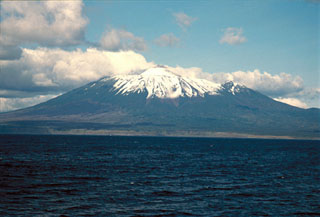Report on Chachadake [Tiatia] (Japan - administered by Russia) — July 1981
Scientific Event Alert Network Bulletin, vol. 6, no. 7 (July 1981)
Managing Editor: Lindsay McClelland.
Chachadake [Tiatia] (Japan - administered by Russia) Vapor emission and glow
Please cite this report as:
Global Volcanism Program, 1981. Report on Chachadake [Tiatia] (Japan - administered by Russia) (McClelland, L., ed.). Scientific Event Alert Network Bulletin, 6:7. Smithsonian Institution. https://doi.org/10.5479/si.GVP.SEAN198107-290030
Chachadake [Tiatia]
Japan - administered by Russia
44.353°N, 146.252°E; summit elev. 1822 m
All times are local (unless otherwise noted)
The crew of a Japanese fishing boat cruising near Kunashir Island observed "smoke" rising from Tiatia on 10 June. During the night of 24 June, an orange glare was observed in the direction of the volcano from [JMA's Nemuro Weather Station], 120 km away. No additional activity has been reported.
Geological Summary. The symmetrical Chachadake, also known as Tiatia, is on the SE side of northern Kunashir Island in the southern Kuriles. The active cone rises above the rim of a filled 2.1 x 2.4 km summit caldera with erosionally furrowed flanks. The central cone, mostly formed by basaltic to basaltic-andesite Strombolian eruptions, rises 400 m above the floor of the caldera and contains a 400 x 250 m wide crater with two explosion vents separated by a linear septum. Fresh lava flows cover much of the SW caldera floor and have overflowed the rim, extending to the foot of the older edifice, which formed during the late Pleistocene or early Holocene. A 500-m-wide crater about 2 km down the SE flank from the caldera rim is surrounded by an unvegetated area of volcanic deposits. The first recorded eruption was in 1812, and a major explosive eruption with lava flows in 1973 originated from vents on the central cone.
Information Contacts: Kyodo Radio, Tokyo.

